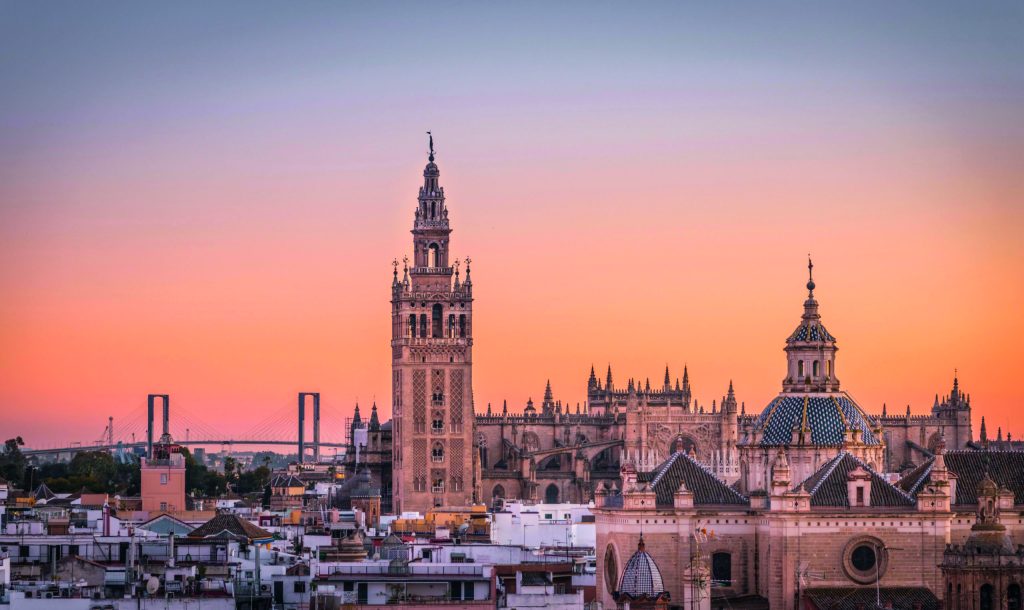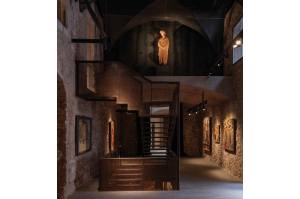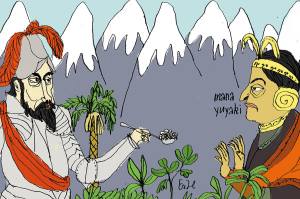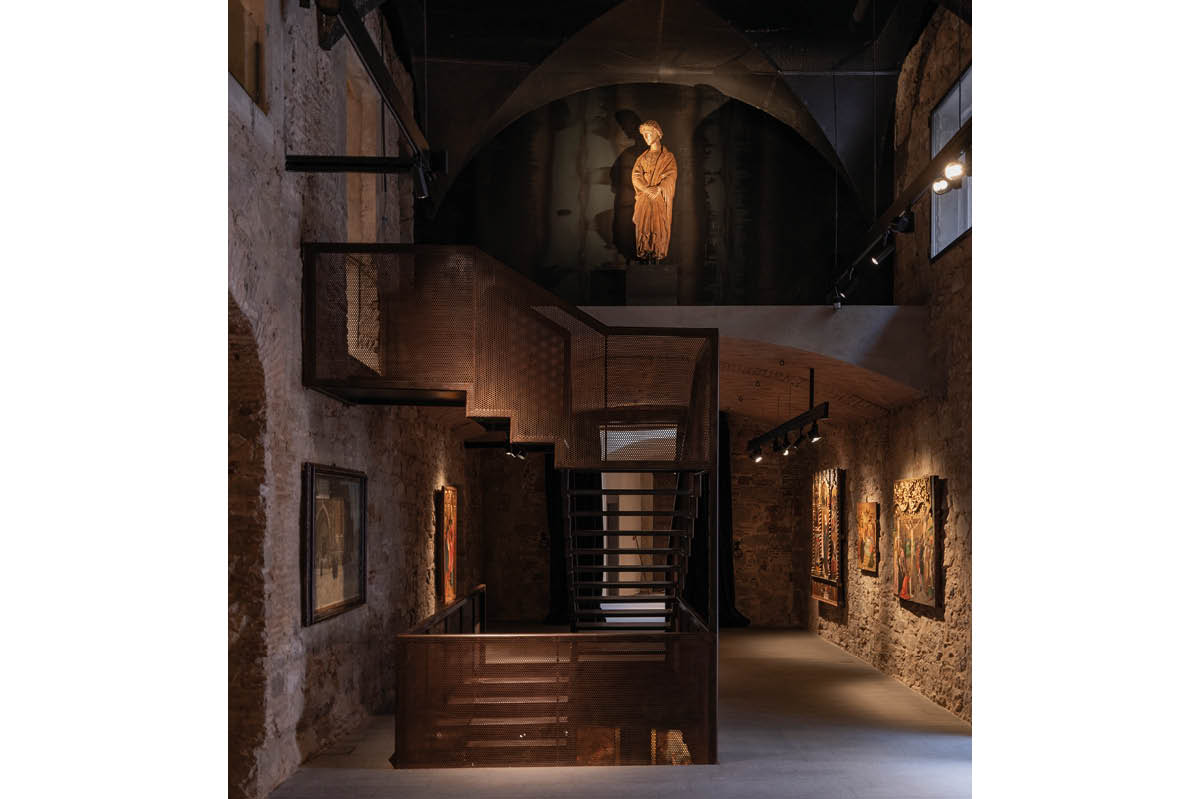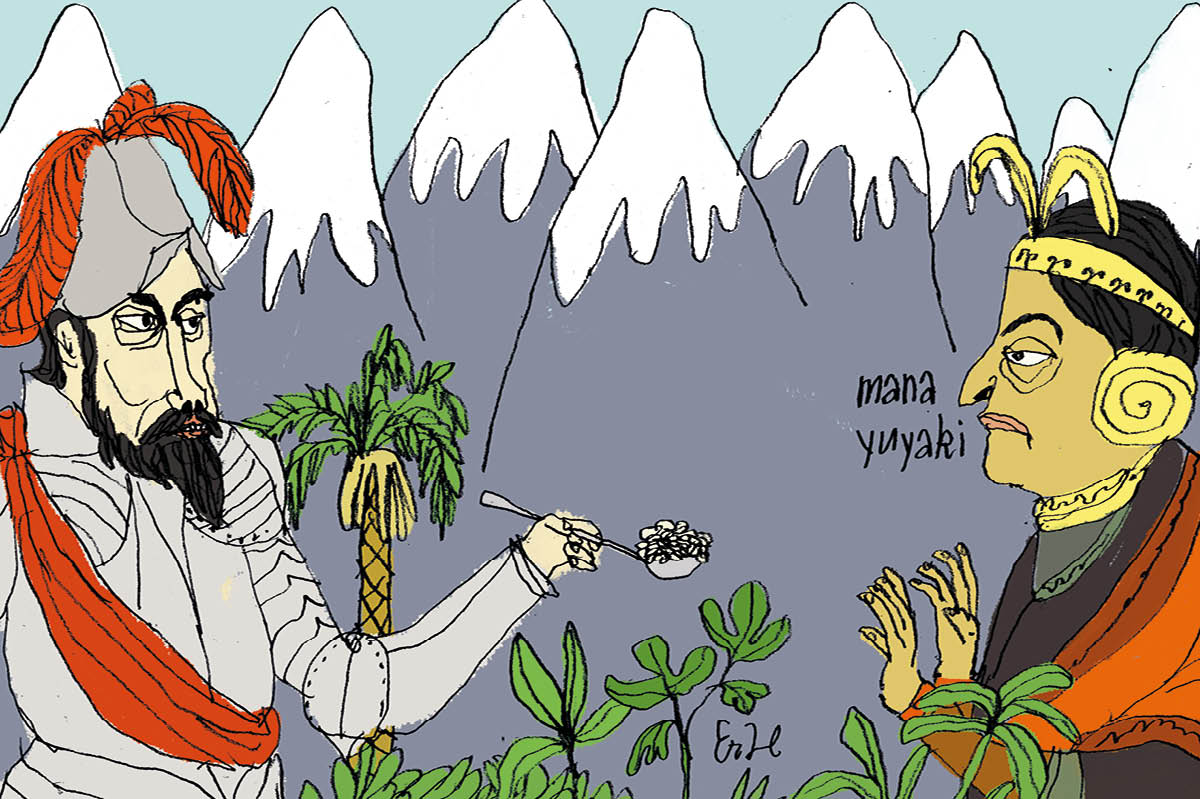It was night when I arrived in Seville. A taxi took me through a maze of winding backstreets then came to an abrupt halt at the head of a pedestrian-only lane. ‘You’ll have to walk from here,’ said the driver.
Uncertainly I dragged my suitcase down one dark alley after another, then suddenly came out onto a plaza lined with orange trees. Soaring above me, spotlit against the black sky, was the cathedral steeple. It was a breathtaking sight with its delicately latticed walls of golden stone, so tall I had to tip my head back to see the spire at the top. The cathedral stretched beside it, filling an entire block.
Four hundred years have passed since Seville was the greatest and most glamorous city on earth, as glittering and alluring as New York City is today. In the 1500s and 1600s it was the only European port of departure for the Americas and had the official monopoly on all Spanish trade with the New World. Seville’s Guadalquivir was the only river in Spain broad and deep enough for ocean-going galleons to navigate. Day and night, vessels laden with gold and silver from the Americas and treasures from the Indies plied their way up it, unloading their bullion at the city’s Royal Docks. Seville was the hub of world trade, a cosmopolitan melting pot of money seekers where merchants from across Europe flocked to acquire goods from the Americas.
While sensible Dutch burghers and British merchants invested their gold, the Spanish lavished theirs on making their city the most spectacular on Earth. There was a huge flowering of the arts. Diego Velázquez produced his early paintings here. Miguel de Cervantes wrote Don Quixote and, as a bit of a low-life character, was even imprisoned here. Don Juan, the legendary if perhaps fictitious seducer, lived in Seville, as did Bizet’s Carmen at a later date.
For Seville this was a second flowering. For more than 500 years it was the capital of successive Muslim dynasties whose empire encompassed Morocco and southern Spain. They built glorious palaces, prayer halls, gardens, universities and, at the center of the city, a magnificent mosque with a towering minaret of exquisitely carved brick and marble. When Seville was captured by King Fernando III in 1248, he transformed the mosque into a church. In 1401 the church fathers decided to build a cathedral to replace the by now damaged mosque, declaring, ‘Let us build a church so beautiful and so grand that those that see it finished will think we are mad.’ They kept the minaret as the bell tower and it remains a stunning reminder of Seville’s Islamic past.
First thing in the morning I was at the mammoth cathedral doors just as they opened. The cathedral really is quite madly beautiful and grand. It’s the largest Gothic cathedral in the world, and its marble walls and vaulted naves dwarf the crowds that mill below. I walked through chapel after chapel filled with priceless art treasures — a Goya, several Murillos and many other paintings and sculptures that have been venerated for centuries. In the choir is an extraordinary, lozenge-shaped wood and marble lectern, with every surface exquisitely carved. On another lectern an illuminated Bible lies open. At the heart of the cathedral is the altar piece, a glittering wall ablaze with gold, intricately carved, depicting 45 scenes from the life of Christ.
At one side of the nave is Christopher Columbus’s tomb. Installed in 1899, it’s in the shape of a casket borne a loft on the shoulders of four life-sized courtiers in crowns and tabards. Whether Columbus’s remains really are inside is a matter of controversy. They’re more likely to be in the Dominican Republic, where he was originally buried. Nevertheless, he deserves pride of place, for it was his momentous voyages that tapped the wealth that made all this possible. Seville’s prosperity drove the age of exploration. The Portuguese Ferdinand Magellan too set off from here in 1519 on his groundbreaking circumnavigation of the globe.
Outside in the plaza, behind the cathedral, music was playing. A couple were dancing, not flamenco but tango, to an audience of rapt observers. Seville’s famous orange trees scented the square. Even in March the brilliant fruits hang among the foliage.
I stopped to watch then headed through the streets to find the Guadalquivir River. In pictures it’s crowded with magnificent galleons with gilded prows and billowing sails. But around the middle of the 17th century it began to silt up. Ocean-going vessels could no longer navigate it, and Seville’s demise began. Today the river is calm and quiet, though boats still ply up and down.
The Torre del Oro — the Tower of Gold— has guarded the river since way before Columbus’s day. It rises among the palm trees, dominating the riverside walk. Built of Seville’s golden stone, it dates from the 13th century and was the last great creation of Seville’s Muslim rulers. It’s an extraordinary 12-sided edifice with three towers unfurling like the barrels of a telescope.
I was eager to see the bullring, a flamboyant donut-shaped building of white stucco which stands right beside the river, with the spire of the cathedral rising in the distance behind it. Seville’s bullring is the oldest, most famous and most important in Spain. Only the greatest matadors appear here. The guided tour takes you through the stables for the bulls and horses and the matadors’ chambers, into a small museum with paintings, posters and fans that evoke the romance of this national sport. Finally you step into the great round arena itself, with its sanded floor, tiers of seats and the white and gold arches from which the bulls and matadors come charging out. You can almost hear the roar of the crowd.
This part of the city, edging the river, a little away from the center, is famous for two things: bull fighting and flamenco. Like entertainers of earlier times all over Europe, dancers and matadors were celebrities yet also firmly beyond the pale; they congregated on the wrong side of the river, in an area called Triana.
To get there you cross a bridge past the Castillo de San Jorge. This was the headquarters and prison of the infamous Spanish Inquisition, which was unleashed in Seville in 1481. The intention was to weed out heretics and put an end to religious diversity. Suspected heretics, including Muslims and Jews who had been forced to convert, were thrown into its dark steamy dungeons, interrogated and often tortured and executed. Today you can enter the dungeons with impunity and explore the museum which preserves mementoes of the Inquisition’s hair-raising past.
Triana today still has a louche, laid-back vibe. It’s a good place to escape the tourists. I found a modest restaurant called Casa Cuesta, with broad windows and an outdoor awning, with every wall covered with bullfighting memorabilia. It serves wonderful Sevillian cuisine: spinach with chickpeas, eggplant with honey, fried squid. Inside the restaurant a video played, showing legendary matadors going through their paces and being mobbed by crowds like rock stars.
I had saved the glorious Real Alcázar for the following day. The Alcázar is the complex of palaces where to this day the King of Spain stays when he’s in town. Its crenellated battlements fringe the square opposite the cathedral, not so much defense as an exuberant flaunting of wealth and power.
The Alcázar embodies the synthesis of cultures — Islamic Moorish, then Christian Spanish — which came together in southern Spain. Its beauty is quite overwhelming. I walked through one exquisitely tiled hall after another, built around courtyards with sunken gardens, shaded with orange trees. To one side is the Casa de Contratación (Contracting House), which controlled trade with Spain’s New World colonies. All imports had to pass through here, and the Casa levied a steep tax on them. Seville’s merchants’ guild worked hand in hand with the Casa, maintaining its monopoly and keeping prices high. In the Casa’s chapel is an altar piece called the Virgin of the Navigators showing Columbus, Amerigo Vespucci and other famous explorers along with indigenous peoples of the colonized territories all gathered at the feet of the Virgin Mary — a tip of the cap to these adventurers who brought about Seville’s wealth.
The glorious heart of the complex is the most exquisite palace of all, the Palacio de Don Pedro, the Palace of King Pedro. Dating from 1364, it was built in the Moorish style by Muslim artisans. Its lavish stonework, every inch covered in exquisite tile, has an almost fairytale delicacy and beauty. Taking pride of place is the Salón de Embajadores, the Hall of Ambassadors, with its domed cupola glittering with stars, slender columns and dazzling tile work. There’s also a spectacular raised gallery from where you can look down on the gardens laid out with palm trees, fountains, lavish greenery, maze and orange trees.
Extending away from the Alcázar and the cathedral is an atmospheric labyrinth of small streets called the Barrio de Santa Cruz. This was the medieval Jewish quarter until 1492: in the very year that Columbus set sail on his world-changing voyage, all Jews who refused Christian baptism were expelled from Spain. I wandered through the quarter, looking out for vestiges of its past. I peeped inside the church of St Maria La Blanca, which started life as a mosque and was converted into a synagogue, then to a church. It’s a rather wonderful white-painted building with an ornate vaulted nave but only the tower at the front and the Gothic doorway remain of the Sephardic synagogue. Walking on I came to the church of St Bartholomew with its heavy Gothic bell tower and discovered that it too had once been a synagogue.
North of the Barrio I came to the Casade Pilatos (the House of Pilate), every bit as lavish as the Alcázar, though on a much smaller scale. Dating from the late-15th century, it is owned by the ducal Medinaceli family. It’s built around a marble-floored courtyard with a fountain spouting from beneath an ancient Roman bust, with other Roman sculptures dotted around. There are beautifully laid out ornamental gardens and in one room a magnificent ceiling covered in a complex geometric design dotted with gold stars.
The age when conquistadors swaggered these streets has long since passed. Yet the legacy of that golden age is everywhere to be seen in Seville’s glorious buildings.
This article was originally published in The Spectator’s April 2021 US edition.



